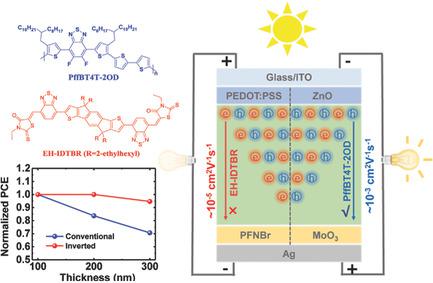当前位置:
X-MOL 学术
›
Adv. Energy Mater.
›
论文详情
Our official English website, www.x-mol.net, welcomes your
feedback! (Note: you will need to create a separate account there.)
Overcoming Space‐Charge Effect for Efficient Thick‐Film Non‐Fullerene Organic Solar Cells
Advanced Energy Materials ( IF 24.4 ) Pub Date : 2018-07-15 , DOI: 10.1002/aenm.201801609 Guichuan Zhang 1, 2 , Ruoxi Xia 2 , Zhen Chen 2 , Jingyang Xiao 2 , Xuenan Zhao 3 , Shiyuan Liu 3, 4 , Hin-Lap Yip 1, 2 , Yong Cao 2
Advanced Energy Materials ( IF 24.4 ) Pub Date : 2018-07-15 , DOI: 10.1002/aenm.201801609 Guichuan Zhang 1, 2 , Ruoxi Xia 2 , Zhen Chen 2 , Jingyang Xiao 2 , Xuenan Zhao 3 , Shiyuan Liu 3, 4 , Hin-Lap Yip 1, 2 , Yong Cao 2
Affiliation

|
Organic solar cells (OSCs) containing non‐fullerene acceptors have realized high power conversion efficiency (PCE) up to 14%. However, most of these high‐performance non‐fullerene OSCs have been reported with optimal active layer thickness of about 100 nm, mainly due to the low electron mobility (≈10−4–10−5 cm2 V−1 s−1) of non‐fullerene acceptors, which are not suitable for roll‐to‐roll large‐scale processing. In this work, an efficient non‐fullerene OSC based on poly[(5,6‐difluoro‐2,1,3‐benzothiadiazol‐4,7‐diyl)‐alt‐(3,3′″‐di(2‐octyldodecyl)‐2,2′;5′,2″;5″,2′″‐quaterthiophen‐5,5′′′‐diyl)] (PffBT4T‐2OD):EH‐IDTBR (consists of electron‐rich indaceno[1,2‐b:5,6‐b′]dithiophene as the central unit and an electron‐deficient 5,6‐benzo[c][1,2,5]thiadiazole unit flanked with rhodanine as the peripheral group) with thickness‐independent PCE (maintaining a PCE of 9.1% with an active layer thickness of 300 nm) is presented by optimizing device architectures to overcome the space‐charge effects. Optical modeling reveals that most of the incident light is absorbed near the transparent electrode side in thick‐film devices. The transport distance of electrons with lower mobility will therefore be shortened when using inverted device architecture, in which most of the excitons are generated close to the cathode side and therefore substantially reduces the accumulation of electrons in the device. As a result, an efficient thick‐film non‐fullerene OSC is realized. These results provide important guidelines for the development of more efficient thick‐film non‐fullerene OSCs.
中文翻译:

克服厚膜非富勒烯有机太阳能电池的空间电荷效应
包含非富勒烯受体的有机太阳能电池(OSC)实现了高达14%的高功率转换效率(PCE)。然而,大多数这些高性能非富勒烯OSC的,已报告有大约100nm最佳活性层的厚度,主要是由于低的电子迁移率(≈10 -4 -10 -5厘米2 V -1小号-1)非富勒烯受体,不适用于卷对卷大规模加工。在这项工作中,基于聚[(5,6-二氟-2,1,3-苯并噻二唑-4,7-二基)-alt-(3,3'''-二(2-辛基十二烷基)的高效非富勒烯OSC )‐2,2′; 5′,2″; 5″,2′″-四噻吩-5,5′′′-二基)](PffBT4T‐2OD):EH‐IDTBR(由富电子茚满[1] ,2-b:5,6-b']二噻吩为中心单元,缺电子的5,6-苯并[c] [1,2,5]噻二唑单元两侧为若丹宁作为外围基团,其厚度为-通过优化器件架构来克服空间电荷效应,提出了独立的PCE(保持9.1%的PCE和300 nm的有源层厚度)。光学建模表明,大多数入射光在厚膜设备的透明电极侧附近被吸收。因此,当使用倒置器件结构时,具有较低迁移率的电子的传输距离将缩短,在该结构中,大多数激子在靠近阴极侧的位置产生,因此大大减少了电子在器件中的积累。结果,实现了高效的厚膜非富勒烯OSC。这些结果为开发更有效的厚膜非富勒烯OSC提供了重要指导。
更新日期:2018-07-15
中文翻译:

克服厚膜非富勒烯有机太阳能电池的空间电荷效应
包含非富勒烯受体的有机太阳能电池(OSC)实现了高达14%的高功率转换效率(PCE)。然而,大多数这些高性能非富勒烯OSC的,已报告有大约100nm最佳活性层的厚度,主要是由于低的电子迁移率(≈10 -4 -10 -5厘米2 V -1小号-1)非富勒烯受体,不适用于卷对卷大规模加工。在这项工作中,基于聚[(5,6-二氟-2,1,3-苯并噻二唑-4,7-二基)-alt-(3,3'''-二(2-辛基十二烷基)的高效非富勒烯OSC )‐2,2′; 5′,2″; 5″,2′″-四噻吩-5,5′′′-二基)](PffBT4T‐2OD):EH‐IDTBR(由富电子茚满[1] ,2-b:5,6-b']二噻吩为中心单元,缺电子的5,6-苯并[c] [1,2,5]噻二唑单元两侧为若丹宁作为外围基团,其厚度为-通过优化器件架构来克服空间电荷效应,提出了独立的PCE(保持9.1%的PCE和300 nm的有源层厚度)。光学建模表明,大多数入射光在厚膜设备的透明电极侧附近被吸收。因此,当使用倒置器件结构时,具有较低迁移率的电子的传输距离将缩短,在该结构中,大多数激子在靠近阴极侧的位置产生,因此大大减少了电子在器件中的积累。结果,实现了高效的厚膜非富勒烯OSC。这些结果为开发更有效的厚膜非富勒烯OSC提供了重要指导。











































 京公网安备 11010802027423号
京公网安备 11010802027423号